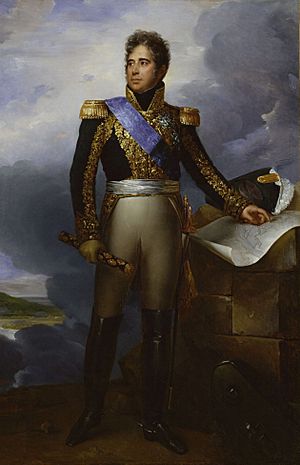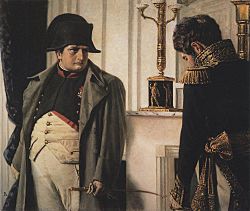Jacques Lauriston facts for kids
Quick facts for kids
Jacques Alexandre Bernard Law de Lauriston
|
|
|---|---|

Portrait by Marie-Éléonore Godefroid
|
|
| Born | 1 February 1768 Pondicherry, French India |
| Died | 12 June 1828 (aged 60) Paris, France |
| Allegiance | |
| Service/ |
Artillery, staff |
| Years of service | 1786-1828 |
| Rank | Marshal of France |
| Battles/wars | French Revolutionary Wars Napoleonic Wars |
| Awards | Légion d'Honneur Order of Saint-Louis |
| Other work | Diplomat |
Jacques Alexandre Bernard Law, marquis de Lauriston (born February 1, 1768 – died June 12, 1828) was a French soldier and diplomat. He was a high-ranking general in the French Army during the time of the Napoleonic Wars. He was born in Pondicherry, which was then part of French India. His father, Jean Law de Lauriston, was the Governor-General there. Jacques was also related to the famous financier John Law.
Lauriston Castle in Scotland was inherited by John Law in 1729. Lauriston's name is one of those carved onto the Arc de Triomphe in Paris.
Contents
Early Career
Becoming a Soldier
Lauriston began his military career around 1786. He worked with artillery and on the general staff during the early Revolutionary Wars. By 1795, he became a brigadier of artillery. He left the army in 1796, but returned in 1800.
Working with Napoleon
When he returned, Lauriston became an aide-de-camp (a personal assistant) to Napoleon. They had been friends since they were young cadets. In the years before Napoleon became emperor, Lauriston held important roles. He directed an artillery school and was a special envoy (a messenger) to Denmark. In 1802, he was chosen to take the official agreement for the Peace of Amiens to England. This peace treaty temporarily ended fighting between France and Great Britain.
Fighting in Europe
By 1805, Lauriston had become a general of division. He fought in the war against Austria. He took control of Venice and the Republic of Ragusa in 1806. In 1807, he became the governor-general of Venice. He was made a count in 1808. He also served with Napoleon during the Peninsular War in Spain (1808–1809). There, he led the division that successfully attacked and captured Pamplona. He also fought under Viceroy Eugène de Beauharnais at the Battle of Raab in Italy.
Fame and High Command
The Battle of Wagram
One of Lauriston's most famous moments was at the Battle of Wagram on July 6, 1809. Austrian forces launched a surprise attack. Napoleon ordered Lauriston to quickly gather a huge group of cannons. This was called a "grand battery." To buy time, Napoleon sent his heavy cavalry to charge the Austrians. While the cavalry bravely fought, Lauriston gathered 112 artillery pieces. He brought together 60 cannons from the Imperial Guard, 24 from a Bavarian division, and 38 from the Army of Italy.
Lauriston moved these cannons close to the enemy. They then opened fire with "grapeshot." Grapeshot was a type of cannonball that broke into many smaller pieces, like a giant shotgun blast. This powerful attack stopped the Austrian army. It gave Napoleon enough time to plan a successful counterattack.
Later Campaigns and Capture
In 1811, Lauriston became the ambassador to Russia. In 1812, he commanded a part of the Grande Armée (Napoleon's main army). He showed great strength and skill in protecting the army during its difficult retreat from Moscow.
He commanded the V Corps at the Lützen and Bautzen in 1813. However, he was captured during the difficult retreat after the Battle of Leipzig in October 1813.
After Napoleon
Lauriston remained a prisoner of war until Napoleon's empire fell. He then joined King Louis XVIII of France. He stayed loyal to the King even during the Hundred Days, when Napoleon briefly returned to power. As a reward, Lauriston was given a seat in the Chamber of Peers, which was like a house of parliament. He also received a command in the Royal Guard.
In 1817, he was given the title of marquis. In 1823, Lauriston was made a Marshal of France, the highest military rank. He commanded a corps during the Spanish expedition. He passed away from a stroke in Paris on June 11, 1828. His name, LAURISTON, is carved on Column 13 of the Arc de Triomphe.
See also
 In Spanish: Jacques Alexandre Law de Lauriston para niños
In Spanish: Jacques Alexandre Law de Lauriston para niños


